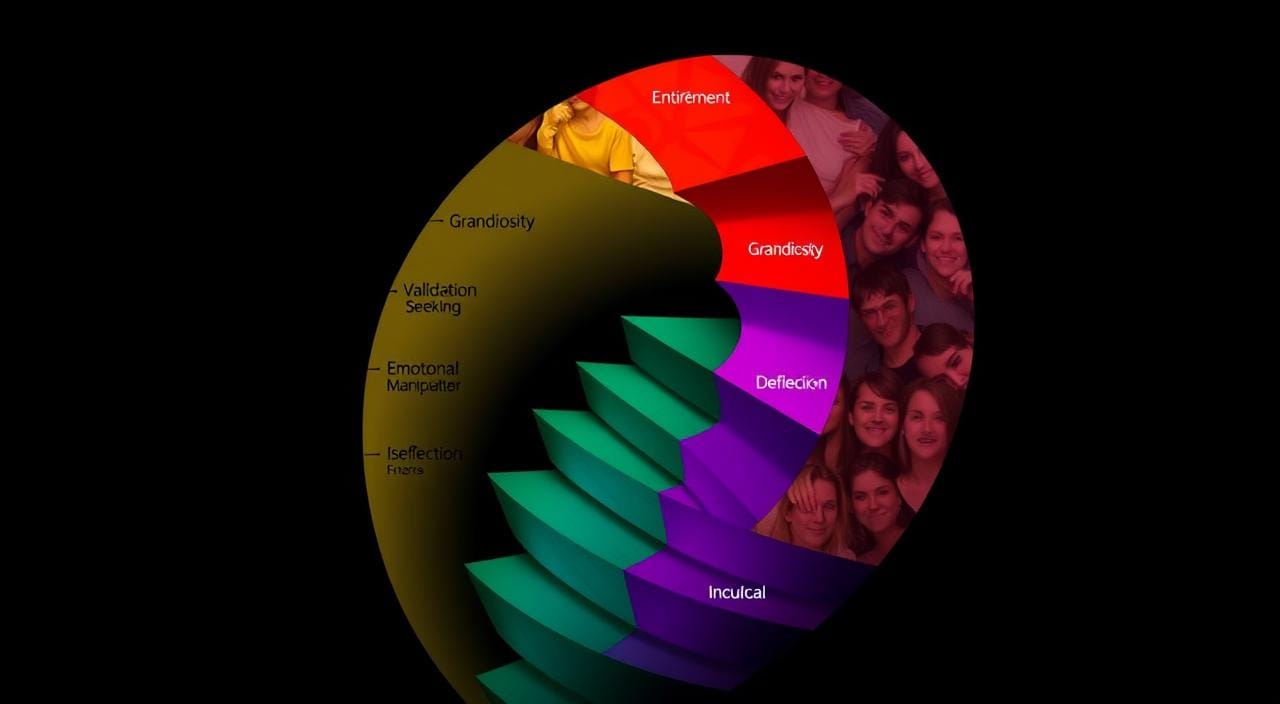Ever felt like you’re always on edge, never knowing when the next emotional storm will hit? This is what many face in narcissistic abuse. The “hoovering” tactic is especially sneaky, aiming to pull you back into a bad relationship1. But, we can spot these signs and keep ourselves safe. I will discuss narcissist hoovering signs in this blog post.
Having been through narcissistic abuse myself, I know how scary it feels. The constant push for control, the sudden mood swings, and empty promises can make you feel trapped. Remember, the issue isn’t you, but the narcissist’s deep flaws2.
Key Takeaways
- Narcissist hoovering is a manipulative tactic used to lure a person back into a destructive relationship.
- Recognizing the red flags of narcissist hoovering is crucial to protecting oneself from further manipulation and abuse.
- Narcissists have an absurd sense of entitlement and will go to great lengths to regain control over their victims.
- Educating yourself about narcissism and its effects can help you understand the relationship dynamic and cope with it better.
- Seeking support and resources can empower you to break free from the cycle of narcissistic abuse.
Understanding Narcissistic Personality Disorder
Narcissistic Personality Disorder (NPD) is a mental health issue. It makes people think they are more important than they are. They also crave admiration and don’t care about others3. It’s hard to spot because there’s no test for it. Doctors look at how people act and think.
What is Narcissistic Personality Disorder?
People with NPD think they are better than everyone else. They feel they deserve special treatment and might use others for their own gain3. They focus a lot on their own success and beauty. They don’t care about others’ feelings because they need to feel good about themselves.
How is Narcissistic Personality Disorder Diagnosed?
Figuring out if someone has NPD is tricky. The signs can be small and different for everyone1. Doctors, like psychologists or psychiatrists, look at how someone thinks and acts. They might talk to the person and their friends or family too1.
While “hoovering” isn’t well-studied in NPD4, some common tactics are seen. These include making someone feel loved too much, changing their mind, and making them feel guilty1. These actions help the narcissist keep control and stop the other person from leaving.
It’s important to understand NPD and know the signs1. Learning about it and getting help can help us deal with narcissistic people. This way, we can have better relationships and take care of our own well-being.
What is Narcissist Hoovering?
Narcissist hoovering is a way for people with narcissistic personality disorder to pull their victims back into a bad relationship. The goal of hoovering is to regain power and control over the victim. They use tactics like love bombing, false apologies, and promises of change to keep the victim in their grasp5.
Narcissists from all walks of life, like family, friends, and ex-partners, use hoovering to get back into a relationship5. Even a small response to a hoover attempt can feed a narcissist’s need for attention5. They often go back to old sources of supply, like ex-partners, instead of looking for new ones5.
It’s wise to block communication channels to stop hoovering attempts5. People who avoid hoovering feel lucky, as it means they’re out of the narcissist’s cycle5. Real apologies from narcissists are rare and usually come with excuses that blame the victim5.
Narcissists use hoovering to avoid guilt and shame for their past actions5. Breaking free from a narcissist can bring significant relief and a more stable life5.

Narcissist hoovering is a manipulative tactic that can have devastating consequences for victims. Understanding the cycle of narcissistic abuse and recognizing the warning signs of hoovering is crucial for protecting oneself and breaking free from the control of a narcissist.
Common Narcissist Hoovering Tactics
Narcissists use many manipulative and emotionally abusive methods without feeling guilty or ashamed6. One tactic they use is called “hoovering.” This happens when they fear their partner is becoming stronger or leaving6. They might reach out through phone calls, texts, cards, or social media6.
Love Bombing and Excessive Flattery
Love bombing and excessive flattery are common tactics for narcissists7. They give their victims lots of attention, affection, and compliments. This makes the victim feel special and creates a false hope of change6.
This tactic is meant to pull the victim back in and regain control over the relationship.
Promises of Change and Apologies
Narcissists also make promises of change or fake apologies6. They might say they’ve learned from their past actions and promise to change. Or they might claim they can’t find anyone as special as their victim6.
These empty promises and false apologies are part of their plan to manipulate and control. They aim to exploit the victim’s vulnerabilities and bring back the unhealthy relationship7.
It’s important to know about these tactics and not engage with the narcissist6. Getting professional help is crucial. It helps you understand and fight narcissistic manipulation. It also helps you set healthy boundaries to avoid going back into an emotionally abusive relationship6.

Narcissist Hoovering Techniques to Look Out For
Narcissists use manipulative tactics without feeling sorry for others, making them dangerous in relationships6. They use “hoovering” when they fear their partner is gaining power or leaving6.
Excuses to Make Contact
Hoovering shows up as sudden contact, like phone calls or texts, after they leave6. They might say they miss you or want to apologize7. They promise to change or make big gestures to pull you back7.
Using Friends and Family
Narcissists also use friends and family to get to you, sneaking back into your life8. They manipulate these loved ones to help them hoover8.
Signs of hoovering include claiming big changes, saying you’re special, or reaching out on special days6. They might even threaten self-harm6. It’s key not to talk to them or let friends pass on messages6.
Knowing these tactics helps you avoid going back to a toxic relationship68. Seek a therapist to set boundaries and break free from manipulation68.

“Narcissists typically come back for more, aiming to start the cycle of abuse all over again as long as they need the victim as a supply.”8
It’s important to resist narcissist hoovering to keep your power and emotional health7. By knowing their tricks and setting strong boundaries, you can escape their control and start anew7.
Gaslighting and Emotional Manipulation
Narcissists use gaslighting and emotional manipulation to pull their exes back into toxic relationships. Gaslighting is a form of abuse where they make the victim doubt their own reality and worth9.
Studies show that 78% of people who experience hoovering feel emotionally manipulated into returning9. The narcissist aims to lower the victim’s confidence and make them rely on their twisted view of things. This makes the victim more open to the narcissist’s control9.
Narcissists also use guilt, love withdrawal, and constant criticism to keep their victims on edge10. These tactics aim to create a desperate and attached feeling, making it tough for the victim to leave9.

It’s key to understand the gaslighting tactics and emotional manipulation in narcissistic abuse to protect oneself10. Knowing these dynamics helps individuals safeguard their well-being and break the abuse cycle9.
Remember, the narcissist’s behavior shows their own insecurities and need for control, not the victim’s worth10. With support and resources, people can spot warning signs, set boundaries, and regain their power against a narcissist’s hoovering9.
Isolation and Control Tactics
Narcissists use isolation and control to abuse their victims. They try to cut the victim off from friends and family. This makes the victim more dependent on the narcissist11.
They also control the victim’s life, like their schedule and money. This is to keep power over the victim11.
These isolation as a form of narcissistic abuse and control tactics in narcissistic relationships are common. They help narcissists keep their victims trapped12.
- Cutting off the victim from their support system
- Controlling the victim’s daily activities and decisions
- Limiting the victim’s access to financial resources
- Dictating the victim’s appearance and style of dress
These tactics make the victim feel dependent and helpless. It’s hard for them to leave the relationship12.

“The more narcissistic an individual is, the more likely they are to view people as objects during the idealization stage of abuse.”13
It’s important for victims to understand these tactics. Recognizing isolation as a form of narcissistic abuse and control tactics in narcissistic relationships is key. It helps them take steps towards healing13.
Narcissist Hoovering Signs
It’s important to watch out for signs of hoovering when dealing with a narcissist. Narcissistic hoovering is when the ex-partner tries to get the victim back for their own needs14. This can be very harmful because narcissists use their victims’ feelings for their own gain14. I will explain narcissist hoovering signs below.
Narcissists might suddenly create a crisis to get sympathy or make the victim feel guilty15. They might also use threats, intimidation, or violence to get what they want15. These actions show they’re trying hard to keep control and get attention from the victim.
Let’s discuss now narcissist hoovering signs.
Sudden Crises or Emergencies
Narcissists might make up or exaggerate problems to get help from their victims15. These could be fake illnesses, accidents, financial issues, or family problems. They want the victim to feel they must help, pulling them back into the toxic relationship.
Threats and Violent Behavior
If other tactics don’t work, some narcissists might use threats or violence15. This could include threats against the victim or their family, or even physical attacks. These actions show they’ll do anything to keep control and stop the victim from leaving.
It’s key for victims to know these signs and act wisely. Setting clear boundaries and not engaging with the narcissist is usually the best way to end the abuse16.
Knowing how narcissists act helps us protect ourselves and our loved ones from their abuse141615.
Responding to Hoovering Attempts
Dealing with a narcissist’s tricks can be tough, but setting clear boundaries is key. Narcissistic hoovering happens after they’ve pushed you away. They try to pull you back in, using guilt or fear to keep you tied to them3.
To fight back, stand firm and take care of yourself. Block their calls, ignore their messages, and surround yourself with people who care. Staying calm and not reacting helps you regain control17.
- Set clear boundaries and communicate them firmly, leaving no room for manipulation.
- Refuse to respond to the narcissist’s hoovering tactics, such as love bombing, excuses to make contact, or using friends and family.
- Prioritize your own well-being by engaging in self-care activities, seeking support from trusted individuals, and pursuing personal growth.
Getting over narcissistic abuse takes time, and fighting hoovering is a big part of it17. Stay focused on your healing and you’ll break free from their hold17.
“The most important thing is to listen to yourself and what you need, even if it’s difficult. Prioritizing your own well-being is the key to breaking free from the narcissist’s grip.”
Recovering from Narcissistic Abuse
Getting over narcissistic abuse is tough but doable. Victims need to first accept what happened and then start to feel better about themselves. They must rebuild their self-esteem and learn to say no18. Getting help from therapists or support groups is key, along with taking care of oneself and being around positive people.
Breaking free from the emotional tie to the abuser is a big step18. With time and the right support, victims can move on and start living again18.
Healing signs include feeling more confident and taking care of oneself. It also means feeling more stable emotionally and less confused18. Victims start to value their independence and trust their gut feelings18.
Healing means learning to trust oneself and feeling worthy of happiness18. It’s about enjoying time with loved ones and finding joy in everyday things18. As victims start to enjoy life, they look forward to the future with excitement18.
“The journey of healing from narcissistic abuse is not an easy one, but it is a necessary step towards reclaiming your life and rediscovering your true self.”
By focusing on healing and self-care, people can overcome narcissistic abuse18. It’s a tough but fulfilling journey. With the right support, victims can take back their lives and live on their own terms.
Conclusion
Understanding and preventing narcissist hoovering is key to taking back our lives after abuse. Knowing how narcissists manipulate, like through love bombing and emotional tricks, helps us protect ourselves19.
Setting strong boundaries and focusing on self-care are crucial steps to heal from narcissistic abuse19. This journey may be tough, but we can overcome it. We can rebuild our self-worth and find better relationships20.
Getting help from therapists and support groups is very important. They help us deal with the emotional scars of narcissistic abuse20. By taking care of our mental and physical health, we can move past the abuse and live freely19.
What is narcissist hoovering?
Hoovering is a tactic used by narcissists to pull someone back into a bad relationship to regain control and continue abuse.
What are common narcissist hoovering tactics?
Narcissists may use love, flattery, apologies, promises to change, or try to reconnect by influencing friends and family.
How do narcissists use gaslighting and emotional manipulation?
They make you doubt your memories and feelings to make you dependent and unsure of yourself.
What are some signs of narcissist hoovering?
Signs include sudden crises, threats, or even violence to regain control.
How should one respond to narcissist hoovering attempts?
Stand firm, cut off contact, block them on social media, and rely on trusted friends for support.
Source Links
- The Manipulative Tactics of Narcissists: Hoovering Explained – https://www.verywellmind.com/narcissistic-hoovering-8407338
- Top 10 Warning Signs of Narcissistic Abuse revealed – https://bartonfamilylaw.com.au/blogs/narcissistic-abuse/top-10-warning-signs-of-narcissistic-abuse-revealed/
- Narcissistic Hoovering: Signs & How to Respond – https://www.simplypsychology.org/narcissistic-hoovering-signs-how-to-respond.html
- Hoovering: Definition, Signs, and Coping Tips – https://psychcentral.com/relationships/hoovering
- 7 Facts to Know About Narcissistic “Hoovering” – https://www.psychologytoday.com/us/blog/here-there-and-everywhere/202209/7-facts-know-about-narcissistic-hoovering
- Spotting the Hoovering Techniques of a Narcissist – https://www.psychologytoday.com/us/blog/addiction-and-recovery/202105/spotting-the-hoovering-techniques-narcissist
- 17 Narcissist Hoovering Examples to Understand the Behavior – https://www.marriage.com/advice/mental-health/narcissist-hoovering-examples/
- 9 Signs of Narcissist Hoovering & How to Respond – https://www.linkedin.com/pulse/9-signs-narcissist-hoovering-how-respond-kamini-wood
- ‘Hoovering’ Is Emotional Blackmail That Makes Gaslighting Look Like Child’s Play – https://www.purewow.com/wellness/hoovering
- What Is Hoovering? Warning Signs & Ways to Deal – https://www.marriage.com/advice/mental-health/hoovering-in-relationship/
- This is what you tell people who don’t believe you were abused by a narcissist – https://sylvialongmire.medium.com/a-guide-to-help-skeptical-friends-and-family-of-narcissistic-abuse-victims-understand-and-believe-9b4d14ac77f5
- ‘Hoover Maneuver’: The Dirty Secret of Emotional Abuse – GoodTherapy.org Therapy Blog – https://www.goodtherapy.org/blog/hoover-maneuver-the-dirty-secret-of-emotional-abuse-0219154/
- The Cycle of Narcissistic Abuse – https://www.narcissisticabuserehab.com/cycle-of-narcissistic-abuse/
- 12 Signs You’re A Victim Of A Hoovering Narcissist – https://www.yourtango.com/heartbreak/signs-of-a-hoovering-narcissist
- Getting This Kind Of Text From Your Ex Is A Big Red Flag – https://www.mindbodygreen.com/articles/hoovering-in-relationships
- Hoovering Narcissist: Definition, Examples, & How to Respond – https://www.wikihow.com/Hoovering-Narcissist
- What Is Hoovering? 7 Signs and How To Handle It – https://health.clevelandclinic.org/hoovering
- 8 Signs You’re Healing From Narcissistic Abuse – https://www.linkedin.com/pulse/8-signs-youre-healing-from-narcissistic-abuse-kamini-wood-wzbqe
- Narcissistic Hoovering: How to Stop the Emotional Rollercoaster – https://www.narcissisticabuserehab.com/narcissistic-hoovering/
- Spotting Narcissistic Abuse: The Toxic Cycle & Other Signs – https://www.kleinattorneys.com/spotting-narcissistic-abuse-the-toxic-cycle-other-signs/







